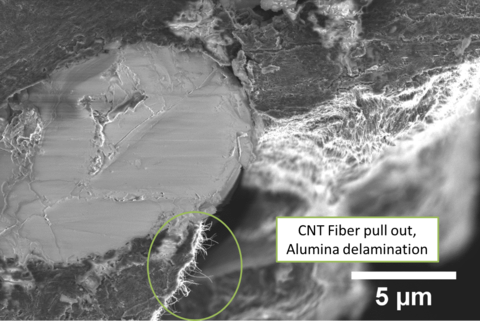Structure and Performance in Hierarchical Nanotubes Networks

Figure 1: The fracture surface of an alumina fiber reinforced composite. The surface of the fiber has been reinforced with multiwall carbon nanotubes. The ability of the nanotubes to pull out from the resin matrix increases the energy required to break the material. This is a function of the surface chemistry and the structure of the carbon nanotubes.
The inclusion of ordered nanomaterials into polymer resins, at volume fractions well above percolation, leads to unique anisotropic properties in the composite. It is only possible to achieve these high concentrations of nanomaterials in a manufacturing environment by attaching the nanomaterials directly to the fiber surfaces prior to adding the polymer resin. Nanomaterials alter aspects of local polymer dynamics such as viscoelasticity, viscoplasticity, and fracture properties (Figure 1). They can also change the local reaction kinetics in thermoset materials. It is important to understand the structure/property relationships to properly engineer these advanced materials. The goal of this project is to control the conformation of nanomaterials during deposition and engineer the polymer-nanomaterial interface to understand how microscale factors such as confinement, friction, adhesion, and conformation control macroscopic properties from quasi-static to dynamic events. The group is using electrophoretic deposition methods to control structure and surface chemistry of multi-wall and single wall carbon nanotubes in confined polymer films and fiber reinforced composites. This project was started in 2015.
Research opportunities may be found here, Opportunity Number: 50.64.31.B8397.
CUSTOMERS/CONTRIBUTORS/COLLABORATORS
Brian Wardle, Massachusetts Institute of Technology
Erik Thostenson, University of Delaware
MAJOR ACCOMPLISHMENTS
We have performed a series of experiments with the Center for Nanoscale Science and Technology (NIST) to measure the dispersion of carbon nanotubes in a polymer resin and relate the dispersion to material properties. We have also worked with the National Center for Neutron Research (NIST) to quantify the effect of the carbon nanotube network on local polymer mobility in the fiber matrix interphase and related this behavior to viscoelastic response of the fiber composite.
Contacts
-
(301) 975-8701

